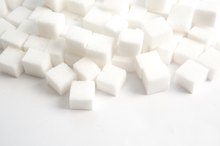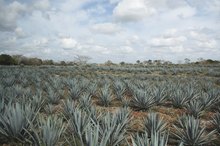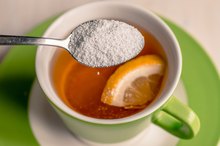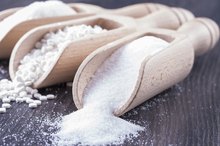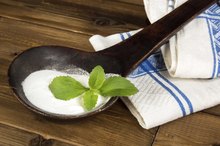Nutrition Information for Splenda
Splenda, an artificial sweetener, contains three different sweetening ingredients. While the manufacturer's website contends that many studies over the past 20 years prove the safety of its main component, sucralose, consumer groups argue just the opposite. In addition, several studies question whether artificial sweeteners in general actually help or hinder weight loss programs. However controversial in terms of overall safety, Splenda does contain some nutritional elements.
Sucralose
One of the main ingredients in Splenda is sucralose. Sucralose tastes 600 times sweeter than sugar. Made from sucrose, which is a combination of the two sugars fructose and glucose, sucralose substitutes three chloride atoms for three hydroxyl or OH groups on the sucrose molecule. These chloride atom substitutions enable sucralose to pass through your body essentially unchanged. Most sucralose ends up in your feces, while a small percentage ends up in your urine. According to the manufacturer's website, sucralose is not metabolized in your body, which is why it is calorie-free. However, a 2000 study by J. P. Finn and G. H. Lord in "Food Chemical Toxicology" reported that a small percentage of sucralose excreted had characteristics of glucuronide conjugates, meaning there was some change that occurred, and a small percentage of sucralose was not recovered, which could indicate that it may have been somewhat metabolized.
Dextrose
Sucrose, Dextrose & Maltodextrin
Learn More
According to the manufacturer's website, Splenda contains a small amount of dextrose. Dextrose, also known as glucose, is a carbohydrate sugar molecule that your body metabolizes and uses for energy. Because Splenda contains less than 1 g per serving of dextrose, it is able to market its product as "no calorie," as it contains less than five calories per serving. However, this may be misleading, because according to the manufacturer's website, each packet contains two servings. Therefore, one packet of Splenda actually contains seven calories, not zero. In addition, because the manufacturer encourages the use of Splenda in recipes, you could add a cupful of Splenda to your recipe thinking it is calorie free, when, in fact, one cup of Splenda contains about 288 calories.
Maltodextrin
Sucralose also contains maltodextrin, a complex carbohydrate processed by your body as a simple sugar. Synthetically made, maltodextrin consists of a long polysaccharide or "many sugar" chain. Basically, it is a long chain of glucose molecules. Again, because the manufacturer defines one serving as half of a packet, despite the addition of this sugar, they can claim the product has no-calories, as it contains less than five calories per serving. Maltodextrin and dextrose are added to provide volume, texture and uniformity of taste.
Fiber
Crystal Light Side Effects
Learn More
A specific variety of Splenda, called Splenda with Fiber, adds 1 g of soluble corn fiber per packet. In this case, one packet is considered one serving size. Healthy adults require about 25 g of fiber daily. While not a particularly rich source of fiber, Splenda with Fiber can help some individuals reduce natural sugar intake while at the same time increase their fiber intake. Soluble dietary fiber forms a gel-like substance that helps lower blood cholesterol and glucose levels. Naturally, soluble fiber is found in oats, peas, beans, apples, citrus fruits, carrots, barley and psyllium.
Sugar Blend
One variety of Splenda, called Splenda Sugar Blend, contains half sucrose, half sucralose. Sucrose specifically improves baking qualities such as texture, browning and moisture; qualities lacking in sucralose. Sucrose also provides calories. One packet, or one-half teaspoon of Splenda Blend contains 10 calories. However, the manufacturer asserts that to provide the same sweetness in baked goods, you only need to use half as much Splenda Blend compared to sugar.
Related Articles
References
Resources
Writer Bio
Robin Wasserman has been writing and prosecuting biochemical patents since 1998. She has served as a biochemical patent agent and a research scientist for a gene-therapy company. Wasserman earned her Doctor of Philosophy in biochemistry and molecular biology, graduating from Harvard University in 1995.
